Top News
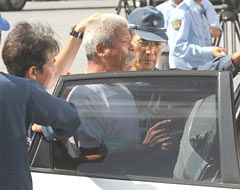
August 17, 2012 Compiled from reports in Ryukyu Shimpo
In the afternoon of August 15, a ship carried seven Hong Kong-based activists to the Senkaku Islands (of the Diaoyu Islands in Chinese). Okinawa Prefectural Police and Coast Guard officials arrested all 14 people involved, including those who landed on the islands on charges of violating Japanese immigration law. The last time that Japanese authorities arrested foreign activists for landing on the disputed islands was eight years ago in March 2004 when seven Chinese were arrested.
On August 16, the Japanese authorities transferred the Chinese activists to the main island of Okinawa. That afternoon, in four police stations in Okinawa, and in patrol boats, the activists were questioned about the reasons and process used to land on the islands. That evening, Coast Guard officials transferred nine of them to the Naha District Office of the Fukuoka Regional Immigration Bureau.
The Japanese authorities transported the five Chinese nationals arrested by the Okinawa Prefectural Police in the patrol boat Kunigami, and transferred them from Uotsuri-jima to the main island of Okinawa. At 8:45am on August 16, they arrived at Naha New Port, from where they were transferred to police stations in Naha, Urasoe and Tomigusuku, Yonabaru. The report said that the Chinese activists all denied the charges when they were arrested.
Coast Guard officials arrested nine of the Chinese suspects, including the captain and crew of the ship, a camera operator and reporter from a television station. All of them denied the charges, stating, “We are innocent because the islands belong to China.” The officials seized the ship and towed it to Ishigaki Port as evidence.
The report said that the activists threw bricks at the Coast Guard vessels preventing it from landing on the islands. Officials said that they did not charge them with interfering with a government official in the act of duty because no one was injured. Article 65 of the Immigration Control and Refugee Recognition Law stipulates that authorities can directly transfer suspects arrested on suspicion of violating the law to the Immigration Bureau, but only if there are no other charges.
On August 17, the Naha District Office of the Fukuoka Regional Immigration Bureau deported all 14 of the Chinese activists. The Japanese authorities swiftly settled the case within two days of the incident occurring.
A civilian airplane took the seven Chinese television crew members from Naha Airport to Hong Kong, where they arrived around 9:00pm. A Coast Guard airplane took the rest of them to Ishigaki Island, from where they departed on their ship at around 9:25pm.
(English translation by T&CT, Mark Ealey)
Go to Japanese
August 19 & 21, 2012 Compiled from reports in Ryukyu Shimpo
On August 18, police arrested a 21 year-old U.S. Marine stationed at Camp Butler, on suspicion of assaulting a woman in Naha. A police spokesperson said that the victim needed a week to recover from the head injury that she suffered in the assault. The suspect has denied the charge, stating that he was merely trying to help the woman who had collapsed on the road.
In the morning, the suspect is said to have pulled the woman to the ground from behind in a residential area and committed an indecent act on her in an alley. Residents heard her scream and rushed to the scene, but the suspect had fled. Police later apprehended him about 300 meters away from the scene of the assault.
On August 20, citizen groups held a rally to voice their anger about the incident. Many people participated in the rally held in front of Camp Zukeran, in Kitanakagusuku. Masaru Shiroma a leader of the Heiwa Shimin Renrakukai (Citizens Coalition for Peace, Okinawa) said, “In the modern history of Okinawa the military has trampled on the human rights of many women. This is something that we have protested about many times. The U.S. military has promised to enforce strict discipline on its personnel, but incidents like this continue to occur. This is essentially what the military are like.”
At the press conference held at the Okinawa Prefectural Office the members of the Okinawan Women Act Against Military Violence voiced their discontent and called for the withdrawal of U.S. forces. They demanded that the U.S. military apologize to the victim and provide physical and psychological care for her, as well as severely punishing the assailant. About the deployment of the Osprey aircraft they said that continued military presence is a threat to the safety of the people and that they should leave Okinawa.
(English translation by T&CT, Mark Ealey)
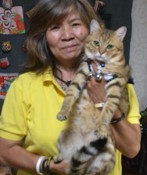
August 18, 2012 Masaaki Umeda of Ryukyu Shimpo
A cat that helps a newspaper delivery woman has gained popularity among local residents. One year-old Fuku belongs to Hiroko Ikei, a newspaper delivery worker at the Nesabu office of the Ryukyu Shimpo in Tomigusuku. Last December, Ikei came across Fuku for the first time when the cat followed her newspaper delivery cart. Before starting to look after the cat she checked for notices at local supermarkets to make sure that it did not belong to someone.
Fuku wakes Ikei with his purring at her bedside at 1:00am, before they go out together on her rounds at 2:00am. The cat stays in the car, sitting on the dashboard quietly and sometimes scowling at anybody who looks inside the car.
Ikei admires and is grateful to Fuku, who follows her every day even during heavy rain and typhoons. She has a health problem and sometimes finds it tough to do the delivery work because she has another job during the day, but says, “I can keep working with Fuku’s support. Fuku is my bodyguard and always makes me drive safety. I will keep doing my newspaper delivery work with him.”
(English translation by T&CT, Lima Tokumori and Mark Ealey)
Go to Japanese
August 13, 2012 Ryukyu Shimpo
An unthinkable accident for peacetime Japan happened in Okinawa on August 13, 2004. A military helicopter operating out of U.S. Marine Corp Futenma Air Station lost control during a training exercise and crashed on the campus of Okinawa International University.
The memory of the accident remains fresh in people’s minds. Accidents like this should not occur, but because Futenma Air Station is located in the heart of a heavily populated urban area, it was also an accident waiting to happen.
During a visit to Okinawa in November 2003, after observing Futenma from the air, U.S. Secretary of Defense Donald Rumsfeld referred to it as “the world’s most dangerous base,” and said that the facilities needed to be relocated as soon as possible. His concern was proven to be correct when a U.S. military helicopter crashed on the campus of Okinawa International University less than a year later.
Be that as it may, the risk to residents has remained unchanged. The governments of Japan and the United States have left this matter unresolved for too long and now need to take their responsibility in this matter seriously. The people of Okinawa have sought to have the facilities currently at Futenma moved outside of the prefecture and to have the land returned. However, the governments have ignored the weight of public opinion, and have stuck to their policy of relocating the base within Okinawa.
The Okinawan people have stood up together to demand that the Futenma base be moved out of the prefecture. The two governments should now respond by respecting public opinion and changing their stance in order to close or move the facilities outside the prefecture or overseas. The time has come to change government policy to avoid further confusion on this issue. This August 13, in addition to the recurring nightmare of the crash, the people face a situation in which the governments are about to deploy an aircraft that has inherent flaws.
Operating the MV-22 squadrons out of USMC Futenma is an act of madness. If the governments deploy them despite the weight of public opinion, the people will criticize what is essentially a display of military-first politics. They should not repeat that mistake, and should not misjudge what the Okinawan people think about this matter. We want to redefine who owns the sky above our prefecture – it is the property neither of the U.S. military, nor of the governments of Japan or the United States. The Okinawan people should own it.
A rally to oppose to the Osprey deployment to the Futenma base will be held on September 9 at the Ginowan Seaside Park. The date of the rally was postponed because of an approaching typhoon. Recalling the 13 August helicopter accident and the lessons that we have learned from it, people should take part in the rally in order to stop the deployment of the Osprey and to help achieve the early return of the land occupied by Futenma Air Station.
(English translation by T&CT, Mark Ealey)
Go to Japanese
August 19, 2012 Hideki Matsudo of Ryukyu Shimpo reports from Washington D.C.
It seems that the flight control computer on an MV-22 Osprey does not follow the pilot’s orders when he is trying to regain control after a steering mistake occurs at low speed. Former chief analyst of the Institute for Defense Analyses Arthur “Rex” Rivolo explained to the Ryukyu Shimpo that that malfunction may have caused the crash on Morocco of the vertical take-off and landing transport aircraft of the same type scheduled to be deployed to Futenma. With regard to that Osprey crash this May, Rivolo said that the aircraft was designed to ignore the pilot’s orders because it maintains its own flight safety at low speeds. Tailwind conditions and overmodulation of the nacelle (a cover that houses all of the generating components in a wind turbine) causing an accident is something unique to the Osprey. Rivolo predicted that such accidents would continue to occur.
The Marine Corps explained that the Osprey’s flight control computer stores tens of thousands of pieces of data per second, and that it points the nose in the correct direction to automatically achieve balance. But even so, it would seem that the aircraft is prone to being affected by human error and strong winds. On August 17, Marine Corps Lieutenant General Robert E. Schmidle Jr., deputy commandant for Marine Corps Aviation, commented on the investigation findings of the cause of the crash in Morocco. He said that the pilot did not notice that the tailwind was pushing the nose down, and that pitching the nacelle forward quickly caused the accident. With regard to whether or not the pilot was able to use the control stick to rein in the aircraft that had lost control, Schmidle said that although the location of the nacelle could influence the situation, the pilot did not have enough authority over the system. He added that the pilot was not able to transmit information to the aircraft despite pulling the control stick back in a situation in which the Osprey was in the middle of switching from aircraft mode to helicopter mode. Schmidle indicated that the Osprey failed to maintain its position when faced with the steering mistake soon after takeoff.
According to Rivolo, the pilot enters the flight details into the flight control computer, which then assumes complete authority to control the aircraft. While the computer follows the pilot’s directions under normal flight conditions, in order to maintain the safety of the aircraft it is designed to ignore the pilot’s orders in flight emergencies such as when flying at low speed.
On the subject of what would happen if the same problem occurred if the Osprey was deployed to Futenma Air Station, Rivolo said that this kind of accident could occur near a runway, and so it would not put the local residents in danger. However, he pointed out that the accident is caused by human error, and would tend to occur due to inattention and fatigue on the part of the pilot. Rivolo predicted that such accidents could continue to occur.
(English translation by T&CT, Mark Ealey)
Go to Japanses
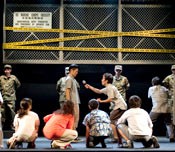
August 13, 2012 Kazuki Furugen of Ryukyu Shimpo
Seinen-Gekijo, a Tokyo-based theater group, will be performing the play Futenma in five different locations in Okinawa for the first time in December. The play depicts the situation surrounding the U.S. helicopter crash onto Okinawa International University and the life of a family made up of three generations living near U.S. Marine Corps Air Station Futenma. It highlights the fact that the U.S. military presence has placed a heavy burden on Okinawa.
Playwright Yoji Sakate wrote Futenma, after carrying out research in Okinawa. It was first performed in Tokyo last September and it will be performed in Kanto, Tokai, Kinki, Shikoku and Okinawa between November and December this year to mark the 40th anniversary of Okinawa’s reversion to Japanese sovereignty.
There is a scene in the play in which after the helicopter crashed the U.S. military enforced a blockade of the campus of Okinawa International University and kept out the local police and the fire brigade. It depicts the daily lives of people who constantly live with the dangers inherent in the military base.
A spokesperson of the Seinen-Gekijo commented, “We decided to perform this show on a national scale because we wanted to deliver this work to as many people as possible. We hope to serve as a bridge between Okinawa and the main islands of Japan.”
Okinawa tour will be held on December 16 at Otori Hall, Yomitan Culture Center, on December 17 at Nago Civic Hall, on December 20 at Uruma Performing Art Center, and on December 21 at Naha Civic Hall.
(English translation by T&CT, Kyoko Tadaoka and Mark Ealey)
Go to Japanese
August 14, 2012 Ryukyu Shimpo
On August 13, the U.S. military canceled the training of the MV-22 Osprey vertical take-off and landing transport aircraft at two airports in Hawaii because of concerns that the downwash generated by the aircraft could impact upon archaeological resources.
This is written in the documents announcing the decision made by the U.S. military forces following the final Environmental Impact Statement (EIS) regarding deployment of the Osprey in Hawaii. The documents revealed that the U.S. military forces considered local residents’ concerns over noise and safety issues, and concerns over destruction of habitats of endangered species. It seems to be the first time that the military forces canceled the Osprey training due to influence of the deployment of the aircraft on natural environment.
The military forces canceled the training at Kalaupapa Airport located on the island of Molokai and Upolu Airport in Hawaii County.
In the documents, the U.S. Marines Corps stated, “The new MV-22 aircraft will introduce greater prop-rotor downwash than that of existing aircraft. Based on prop-rotor studies, the potential area of effect is defined as an area encompassed by a circle with a radius of 350 feet (107 meters) measured from the aircraft’s landing point.” The documents explained, “Due to concerns about potential impacts of MV-22 rotor downwash on archaeological resources located adjacent to Kalaupapa Airport, the Marine Corps modified the proposed action in the Final EIS to remove MV-22 use of Kalaupapa Airport for training.”
Also, in the agreement reached between the U.S. Marines Corps and the Advisory Council on Historic Preservation in Hawaii there is mention that the U.S. military will limit the use of Upolu Airport to emergency landings because the airport is located just 1.6 kilometers west of the birthplace of King Kamehameha I, who established the Kingdom of Hawaii.
The U.S. military plan to deploy 24 Osprey to the Kaneohe Bay base in Hawaii by 2018. In the preparatory document of the EIS, the military proposed that in 2018 the aircraft will be used at Kalaupapa Airport 684 times, and at Upolu Airport 228 times. With regard to the deployment of the Osprey in the United States, the military postponed training exercises because many local residents were concerned about the safety of the low-altitude flight training of the Air Force CV-22 in New Mexico.
(English translation by T&CT, Mark Ealey)
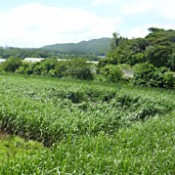
August 14, 2012 Takahiro Shinjo Correspondent of Ryukyu Shimpo
On August 4, an area of sugarcane more than a dozen meters across was mysteriously flattened in a field behind a kamiasagi, or sacred place, in the Sakiyama district of Nakijin.
During a work break, Takashi Azama, who was doing construction work nearby, found the spot that does not have any access to a road. Thick and strong sugarcane plants about two meters high were flattened in the same direction more than a dozen meters across at two separate locations, but it would seem that neither tractors nor humans have been there.
Nothing out of the ordinary was detected until the previous night so the sugarcane would appear to have been flattened some time during the night of August 3 and 4, but it is unclear whether or not this is someone’s handiwork or if it was caused by some kind of natural phenomenon. Azama suggested, “Maybe Godzilla stomped on them.”
(English translation by T&CT, Mark Ealey)
Go to Japanese
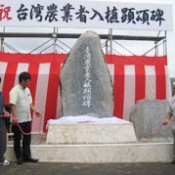
August 11, 2012 Ryukyu Shimpo
On August 10, an unveiling ceremony of a monument to honor Taiwanese farmers was held in the southern parking area of Nagura Dam on Ishigaki. These farmers introduced the pineapple industry and water buffalo culture to Yaeyama in the prewar period and contributed greatly to agricultural development on the island. About 100 people attended the ceremony, including local residents who worked to establish the monument and descendants of the Taiwanese farmers. In the past, there has been friction between Taiwanese immigrants and locals, but now these people have created a new page in Yaeyama history.
In 1935, the Daido-Takushoku Pineapple Company in central Taiwan recruited 330 people of about 60 households, and these workers and their families migrated to Nagura and Takeda areas in Ishigaki. They used water buffaloes to develop previously untamed land, but local people who had plowed their land manually felt threatened and this created conflict between the two groups. As a result,
Taiwanese farmers suffered a great deal of discrimination from the local people.
However, the agricultural know-how that the Taiwanese immigrants brought with them was innovative and made an enormous contribution to agriculture in Yaeyama. For this reason, last March, people from various communities established a group to erect a monument to recognize the contribution of the Taiwanese immigrants.
Tsuyoshi Iha, the president of the group, said, “We built the monument to recognize the achievements of Taiwanese farmers in a lasting way. I really appreciate what they did.” He went on to say that he hoped to maintain the current level of friendly relations, which had changed from the antagonism that existed just half a century ago.
(English translation by T&CT, Lima Tokumori and Mark Ealey)
Go to Japanese
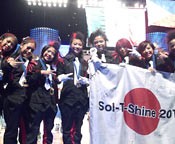
August 10, 2012 Ryukyu Shimpo
The World Hip Hop Dance Championship 2012 was held from August 1 to 5 at the Orleans Arena in Las Vegas. About 300 teams from about 40 countries participated in the event. Sol-T-Shine, a team made up of eight Okinawan children in elementary and junior high school, won the first prize in the varsity category for 12 to 18 year-olds.
The members are the pupils of T-da Dance Studio in Chatan: Kira Matsuda who is in the third year of Furugen Junior High School, Hinano Nishihara and Nanase Tomimura in the second year of Ginowan Junior High School, Hijiri Matsudo in the first year at the same school, Kako Tokumoto in the second year of Nakagusuku Junior High School, Kirina Harada in the first year of Matsushiro Junior High School, Runa Toma in the first year of Iraha Junior High School and Ramu Inamine who is in the six year of Furugen-Minami Elementary School.
Sol-T-Shine came first, progressing through the preliminaries and the semifinal in a category in which there were 41 teams from all over the world. At the final stage of the contest, the power of their performance brought them out ahead of some world-class competitors. Matsuda said, “We worked really hard to compete in this event, so the result brought tears to my eyes. I’m very grateful to the teachers who supported us with assistance on choreography and by creating music for us.”
Katsuya Rocco Hudson, the head of the studio, said, “I’m proud of them for having worked so hard in training for achieving their dream and goal.”
(English translation by T&CT, Lima Tokumori and Mark Ealey)
Go to Japanese

August 15, 2012 Ryukyu Shimpo
Shipments of shima dofu are on the rise. A year after it began to gradually expand the scale of its business, Hokugan Co., Ltd, which started shima dofu production at Nikko in Tochigi in 2009, increased its volume of shipment by 2.5 times, to 280 tons, and now aims to double that again. Other companies that produce shima dofu in Okinawa and ship it out of the prefecture have also lifted their profile at Okinawan product exhibitions and have increased their volume of shipment.
Starting production in Tochigi has led to a broad expansion of their business around the Tokyo metropolitan area. Hokugan has increased the volume of shipments mainly during summer by working with major companies such as Itoyokado and Ion as well as selling to small and medium-sized enterprises, Okinawan restaurants and bars. As a result, the volume of product shipped increased to a record-high of 46 tons in July in comparison to just one ton a month at the beginning of this year. Hokugan’s target is to ship more than 500 tons a year.
Michiru Miyagi a member of the company’s Planning and Development Section says, “Compared to other types of tofu, shima dofu is more elastic and flavorsome. This fact is now more well-known by customers, and as more people grow goya (bitter melon) to help counter extreme heat, the number of people who make champuru (stir-fry) with shima dofu increases as well.” Their current challenge is to come up with different ways to eat shima dofu and to get people to consume it throughout the year.
Meanwhile, Hiroshiya Shokuhin, which has been producing food in Okinawa for 38 years, has boosted its profile through Okinawan product exhibitions held across the country. Five years ago, it dispatched 30 to 40 tons from Okinawa each year, but this year shipment levels are expected to reach 200 tons, a level that would represent nearly 40% of all volume shipped.
Hachidai Itokazu, the sales manager of the company, said confidently, “We can carry out sales face to face at food exhibitions designed to showcase our products. If we sell good quality products, the customers will buy them.” Meanwhile, he is also concerned about maintaining the quality of the product, saying, “We are not sure if we will increase the volume of shipment of Okinawa because if we look to make too much, it might affect the taste.” He also referred to challenges in terms of expanding the consumption on the main islands of Japan, saying that other manufacturers may take market share from Okinawan producers if they don’t clearly define the term shima dofu.
A representative of the Sales and Distribution Division of the Okinawa Products Association, which runs Okinawa product exhibitions nationwide at least once every two months, said, “Shima dofu has a broad range of uses such as in champuru and yushi dofu, so it is easy to use in everyday meals. That is why boosting levels of consumption is relatively straightforward.”
(English translation by T&CT, Megumi Chibana and Mark Ealey)
Go to Japanese







 Webcam(Kokusai Street)
Webcam(Kokusai Street)


